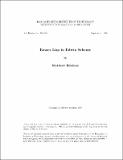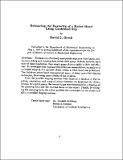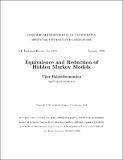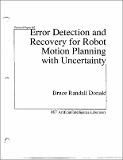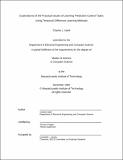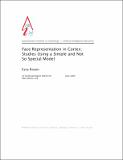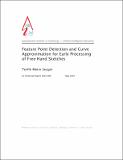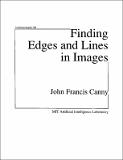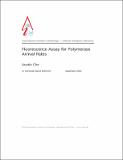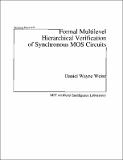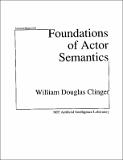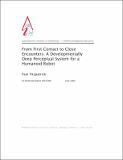Browsing AI Technical Reports (1964 - 2004) by Title
Now showing items 86-105 of 327
-
Emacs Lisp in Edwin SScheme
(1993-09-01)The MIT-Scheme program development environment includes a general-purpose text editor, Edwin, that has an extension language, Edwin Scheme. Edwin is very similar to another general-purpose text editor, GNU Emacs, which ... -
Embodiment and Manipulation Learning Process for a Humanoid Hand
(1995-05-01)Babies are born with simple manipulation capabilities such as reflexes to perceived stimuli. Initial discoveries by babies are accidental until they become coordinated and curious enough to actively investigate their ... -
Enhanced Reality Visualization in a Surgical Environment
(1995-01-01)Enhanced reality visualization is the process of enhancing an image by adding to it information which is not present in the original image. A wide variety of information can be added to an image ranging from hidden ... -
Enhancing the Dexterity of a Robot Hand Using Controlled Slip
(1987-05-01)Humans can effortlessly manipulate objects in their hands, dexterously sliding and twisting them within their grasp. Robots, however, have none of these capabilities, they simply grasp objects rigidly in their end ... -
Equivalence and Reduction of Hidden Markov Models
(1993-01-01)This report studies when and why two Hidden Markov Models (HMMs) may represent the same stochastic process. HMMs are characterized in terms of equivalence classes whose elements represent identical stochastic processes. ... -
Error Detection and Recovery for Robot Motion Planning with Uncertainty
(1987-07-01)Robots must plan and execute tasks in the presence of uncertainty. Uncertainty arises from sensing errors, control errors, and uncertainty in the geometry of the environment. The last, which is called model error, has ... -
Explorations of the Practical Issues of Learning Prediction-Control Tasks Using Temporal Difference Learning Methods
(1992-12-01)There has been recent interest in using temporal difference learning methods to attack problems of prediction and control. While these algorithms have been brought to bear on many problems, they remain poorly understood. ... -
Face Representation in Cortex: Studies Using a Simple and Not So Special Model
(2003-06-05)The face inversion effect has been widely documented as an effect of the uniqueness of face processing. Using a computational model, we show that the face inversion effect is a byproduct of expertise with respect to the ... -
Fat-Tree Routing for Transit
(1990-02-01)The Transit network provides high-speed, low-latency, fault-tolerant interconnect for high-performance, multiprocessor computers. The basic connection scheme for Transit uses bidelta style, multistage networks to ... -
Feature Extraction Without Edge Detection
(1993-09-01)Information representation is a critical issue in machine vision. The representation strategy in the primitive stages of a vision system has enormous implications for the performance in subsequent stages. Existing ... -
Feature Point Detection and Curve Approximation for Early Processing of Freehand Sketches
(2001-05-01)Freehand sketching is both a natural and crucial part of design, yet is unsupported by current design automation software. We are working to combine the flexibility and ease of use of paper and pencil with the processing ... -
Finding Edges and Lines in Images
(1983-06-01)The problem of detecting intensity changes in images is canonical in vision. Edge detection operators are typically designed to optimally estimate first or second derivative over some (usually small) support. Other ... -
Finding Texture Boundaries in Images
(1987-06-01)Texture provides one cue for identifying the physical cause of an intensity edge, such as occlusion, shadow, surface orientation or reflectance change. Marr, Julesz, and others have proposed that texture is represented ... -
Flexibility and Efficiency in a Computer Program for Designing Circuits
(1977-06-01)This report is concerned with the problem of achieving flexibility (additivity, modularity) and efficiency (performance, expertise) simultaneously in one AI program. It deals with the domain of elementary electronic circuit ... -
Fluorescence Assay for Polymerase Arrival Rates
(2003-08-31)To engineer complex synthetic biological systems will require modular design, assembly, and characterization strategies. The RNA polymerase arrival rate (PAR) is defined to be the rate that RNA polymerases arrive at a ... -
Formal Multilevel Hierarchical Verification of Synchronous MOS Circuits
(1987-06-01)I have designed and implemented a system for the multilevel verification of synchronous MOS VLSI circuits. The system, called Silica Pithecus, accepts the schematic of an MOS circuit and a specification of the circuit's ... -
Foundations of Actor Semantics
(1981-05-01)The actor message-passing model of concurrent computation has inspired new ideas in the areas of knowledge-based systems, programming languages and their semantics, and computer systems architecture. The model itself ... -
From First Contact to Close Encounters: A Developmentally Deep Perceptual System for a Humanoid Robot
(2003-06-01)This thesis presents a perceptual system for a humanoid robot that integrates abilities such as object localization and recognition with the deeper developmental machinery required to forge those competences out of raw ... -
From Genetic Algorithms to Efficient Organization
(1994-05-01)The work described in this thesis began as an inquiry into the nature and use of optimization programs based on "genetic algorithms." That inquiry led, eventually, to three powerful heuristics that are broadly applicable ... -
Gait Analysis for Classification
(2003-06-26)This thesis describes a representation of gait appearance for the purpose of person identification and classification. This gait representation is based on simple localized image features such as moments extracted from ...

